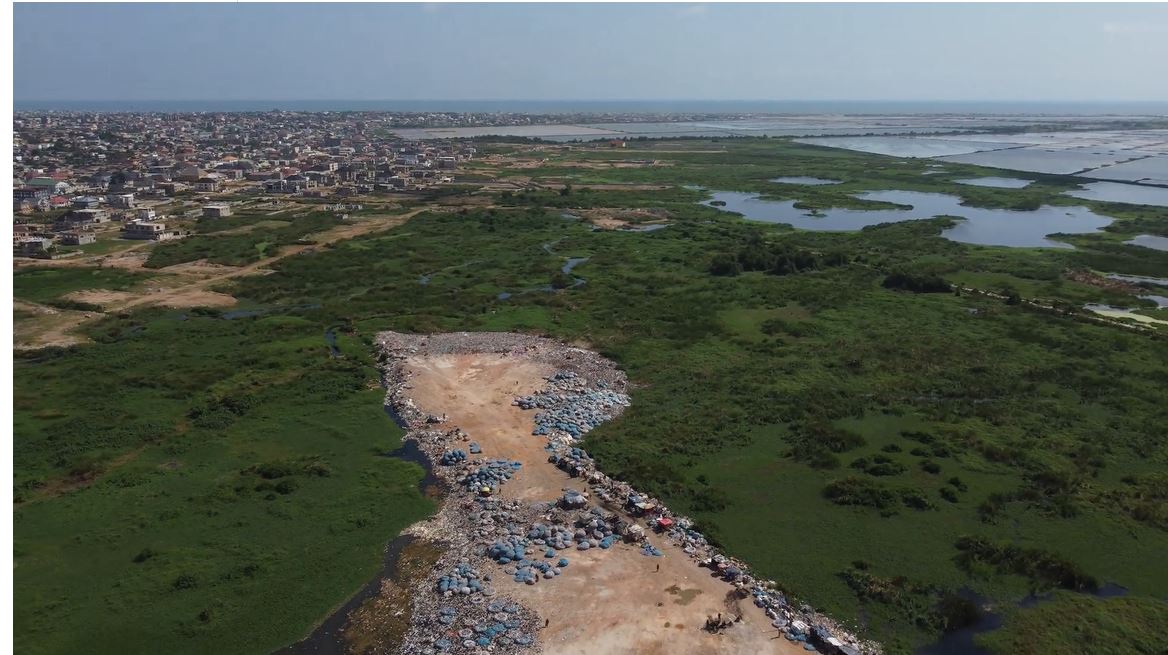An investigative report by Unearthed in collaboration with Greenpeace Africa has uncovered that clothes discarded by UK consumers are turning up in massive waste dumps within Ghana’s protected wetlands. Garments bearing the labels of major UK and European fashion brands including Next, Marks & Spencer, George at Asda, Zara, H&M, and Primark have been found not only in inland dumps but also washing ashore on beaches and clogging waterways.
These illegal textile dumping grounds have been located in areas designated as Ramsar sites, internationally recognized for their ecological importance. The Densu Delta, one such site, is a sanctuary for endangered leatherback and green turtles, as well as migratory birds like roseate terns and curlew sandpipers. Despite its protected status, new dumpsites have been carved into the landscape, stripping vegetation and laying waste perilously close to lagoons and streams. In the Akkaway area, drone footage revealed open piles of garments resting on bare earth, without any of the pollution control measures found in engineered landfills, such as lined bases or leachate collection systems.
Local residents who rely on these wetlands for their livelihoods say the effects have been devastating. “Before, you could drink the river water. But now it’s black,” said Seth Tetteh, a fisherman who has lived near the Densu Delta for seven years. “When you cast your net, it brings in fish, clothes and other things. It’s very tedious.” Ibrahim Sadiq, a 19-year-old student, recalled the area’s previous biodiversity alligators, birds, and bush cats before pollution overtook the region. Now, stagnant pools of contaminated water bring unbearable stench and mosquito swarms.
At the heart of the crisis is Ghana’s Kantamanto Market in Accra, one of the world’s largest second-hand clothing markets, which receives over 1,000 tonnes of garments each week. However, traders say the quality of imports has deteriorated drastically. “In the past, we had good clothes to sell to take care of our families, but these days the used clothes are poorly made and already falling apart when we open the bales,” said market vendor Mercy Asantewa.
The city of Accra is overwhelmed. According to Solomon Noi, head of Accra’s waste management department, about 100 tonnes of garments leave Kantamanto daily as waste, yet the city can collect and process only 30 tonnes. The remaining 70 tonnes are dumped in open drains, lagoons, wetlands, and coastal areas. There is only one engineered landfill in the region, with a second currently under construction.
The scale of the UK’s textile waste contribution is staggering. Every year, UK consumers discard approximately 1.5 million tonnes of used textiles. Of that, about 730,000 tonnes are either incinerated or landfilled. From the 650,000 tonnes destined for reuse or recycling, 420,000 tonnes—over two-thirds—are exported abroad, with Ghana receiving more than any other nation.
Calls for legislative reform are growing louder. In 2023, a group of Ghanaian traders visited Brussels to lobby for the European Union to introduce extended producer responsibility (EPR) legislation that would hold fashion brands accountable for the environmental consequences of their products at end-of-life. Similarly, the UK’s Textile Recyclers Association has petitioned the government to adopt a comparable policy.
Some fashion giants claim to be taking steps. Marks & Spencer says it does not export excess clothing and now offers repair services through Sojo, alongside in-store recycling initiatives in partnership with Oxfam and Handle. George at Asda insists its production volumes have not increased in a decade and boasts more than 800 recycling banks across the UK. Primark maintains that it does not authorize any garments from its textile takeback schemes or unsold inventory to be sent to Ghana or any other part of Africa.
“We know that no single company can solve the issue of textile waste alone,” a Primark spokesperson said. “Real progress will only come if the industry comes together.”
H&M echoed similar sentiments, acknowledging the challenges posed by inadequate waste management systems in receiving countries. Zara’s parent company, Inditex, has voiced support for government-mandated EPR policies, arguing that only uniform regulation can establish accountability and promote circularity.
Yet, on the ground in Ghana, change remains distant. Protected ecosystems are being buried under mounds of synthetic waste. Local governments appear to be in breach of both national environmental regulations and international commitments under the Ramsar Convention. The Weija Gbawe municipal assembly, which supervises the Akkaway dump, has failed to respond to formal requests for comment regarding its role in the destruction of the wetland.
The textile waste crisis highlights the darker side of the fast-fashion economy: while consumers in the Global North continue to purchase disposable clothing at breakneck speeds, the Global South is left to deal with the environmental and social fallout. As Ghana’s rivers blacken and biodiversity vanishes beneath heaps of unwanted garments, the need for urgent, systemic change is undeniable—and overdue.
